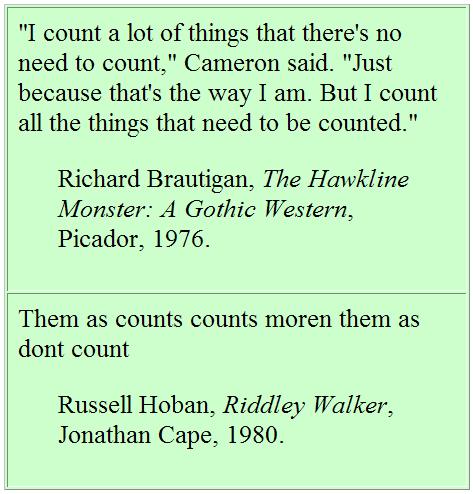For novelist Russell Hoban, who died yesterday—
"Hoban once ruefully observed that death would be a good career move:
'People will say, "Yes, Hoban, he seems an interesting writer, let’s look at him again."'"
For novelist Russell Hoban, who died yesterday—
"Hoban once ruefully observed that death would be a good career move:
'People will say, "Yes, Hoban, he seems an interesting writer, let’s look at him again."'"
From Peter J. Cameron's weblog today—
According to the Buddha,
Scholars speak in sixteen ways of the state of the soul after death. They say that it has form or is formless; has and has not form, or neither has nor has not form; it is finite or infinite; or both or neither; it has one mode of consciousness or several; has limited consciousness or infinite; is happy or miserable; or both or neither.
He does go on to say that such speculation is unprofitable; but bear with me for a moment.
With logical constructs such as “has and has not form, or neither has nor has not form”, it is perhaps a little difficult to see what is going on. But, while I hesitate to disagree with the Compassionate One, I think there are more than sixteen possibilities described here: how many?
Cameron's own answer (from problem solutions for his book Combinatorics)–
One could argue here that the numbers of choices should be multiplied, not added; there are 4 choices for form, 4 for finiteness, 2 for modes of consciousness, 2 for finiteness of consciousness, and 4 for happiness, total 28 = 256. (You may wish to consider whether all 256 are really possible.)
Related material– "What is 256 about?"
Some partial answers–
April 2, 2003 — The Question (lottery number)
May 2, 2003 — Zen and Language Games (page number)
August 4, 2003 — Venn's Trinity (power of two)
September 28, 2005 — Mathematical Narrative (page number)
October 26, 2005 — Human Conflict Number Five (chronomancy)
June 23, 2006 — Binary Geometry (power of two)
July 23, 2006 — Partitions (power of two)
October 3, 2006 — Hard Lessons (number of pages,
as counted in one review)
October 10, 2006 — Mate (lottery number)
October 8, 2008 — Serious Numbers (page number)
Quoted here Nov. 10, 2009—
Epigraphs at
Peter Cameron’s home page:

From "Time's Breakdown," September 17, 2003—
|
“… even if we can break down time into component Walsh functions, what would it achieve?” – The Professor, in “Passing in Silence,” by Oliver Humpage “Being is not a steady state but an occulting one: we are all of us a succession of stillness blurring into motion on the wheel of action, and it is in those spaces of black between the pictures that we find the heart of mystery in which we are never allowed to rest. The flickering of a film interrupts the intolerable continuity of apparent world; subliminally it gives us those in-between spaces of black that we crave.” – Gösta Kraken, Perception Perceived: an Unfinished Memoir (p. 9 in Fremder, a novel by Russell Hoban) |
This flashback was suggested by
DeLillo is a major novelist, but the work of Hoban seems more relevant to the phrase "frame by frame."
Epigraphs at
Peter Cameron’s home page:

See also the epigraphs in Cameron’s
Parallelisms of Complete Designs,
entries on this date three years ago,
Russell Hoban in this journal,
and
The Hawkline Monster in this journal.
Happy Ending
From yesterday morning:
|
“At three o’clock in the morning For June Carter Cash as Eurydice, Let us pray that Jesus College |
From Jesus College, Oxford —
Not the Jesus I had in mind, but it will do:
“… Filled with despair, Orpheus dragged himself back to earth with only his music left to him…. In death Orpheus once more entered the Underworld, still playing the lyre. He and Eurydice were permanently reunited. Many scholars see Orpheus as another pagan prototype of Christ.”
Amen.
Time’s Breakdown
“… even if we can break down time into component Walsh functions, what would it achieve?”
— The Professor, in “Passing in Silence,”
by Oliver Humpage
“Being is not a steady state but an occulting one: we are all of us a succession of stillness blurring into motion on the wheel of action, and it is in those spaces of black between the pictures that we find the heart of mystery in which we are never allowed to rest. The flickering of a film interrupts the intolerable continuity of apparent world; subliminally it gives us those in-between spaces of black that we crave.”
— Gösta Kraken, Perception Perceived: an Unfinished Memoir (p. 9 in Fremder, a novel by Russell Hoban)
“The Underground’s ‘flicker’ is a mechanical reconciliation of light and darkness, the two alternately exhibited very rapidly.”
— Hugh Kenner on T. S. Eliot’s “Burnt Norton” in Four Quartets
From last year’s entries:
ART WARS September 12, 2002
|
|
|
Artist Ben Shahn was born on this date in 1898. |
For some further reflections on flickering time,
see an essay by Nicholson Baker on
the Geneva mechanism
in movie projectors.
“At three o’clock in the morning
Eurydice is bound to come into it.”
—Russell Hoban,
The Medusa Frequency
For June Carter Cash as Eurydice,
see The Circle is Unbroken.
Let us pray that Jesus College
will help this production,
with Johnny Cash as Orpheus,
to have a happy ending.
Powered by WordPress